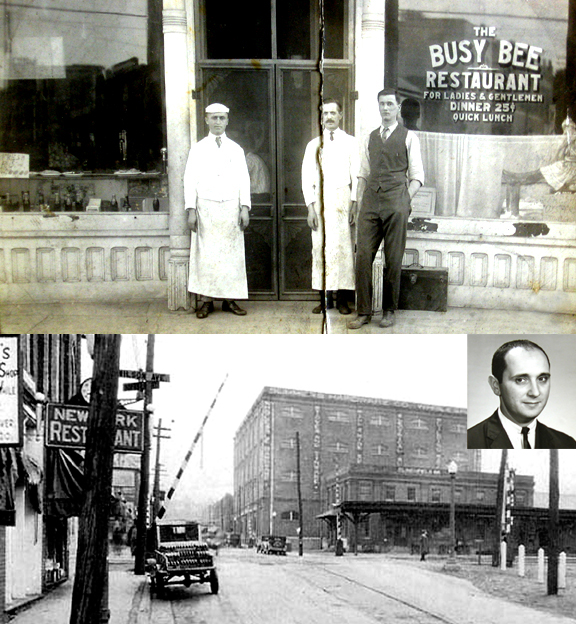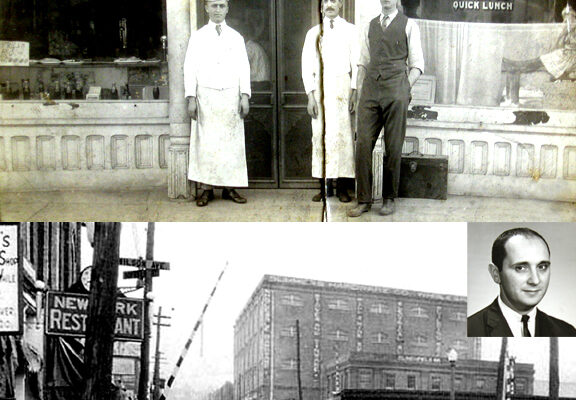“I am in love with Johnson City,” proclaimed George Buda during an interview at his and Wanda’s “tree streets” neighborhood home. For the next two hours, George tirelessly unleashed a barrage of favorite memories beginning with his family. John and Ethel Buda, George’s parents, came to America from Albania prior to 1920 before migrating to Johnson City that year.

Top: The Busy Bee Restaurant. John Buda is on the left and his brother, Charles, is on the right. Bottom: The New York Restaurant. Insert: George Buda. Both photos are from the 1920s
John and his brother, Charles, initially went to work for Mike Dimma at his Busy Bee Restaurant located at 119-21 Fountain Square. Painted on the store window were the words: “For Ladies and Gentlemen, Dinner 25 Cents, Quick Lunch.” A small sign along the left side of the window advertised “Fresh Pies.”
In 1922, John opened his own restaurant, the New York Café, at 209 Buffalo Street near Wilson Avenue. Charles also worked there. The business was located on the ground floor and the family lived upstairs. George fondly recalled the view from an upstairs window: “We could look out and watch the ET&WNC train, known as “Tweetsie,” pass by. We also saw trains traveling to and from the old CC&O Depot.”
John managed the business for almost 20 years. Around 1939, he sold it to Jim Kalogeros when the Buda family moved to Miami to assist John’s brother in a restaurant venture. They returned to the city near the end of the war because, according to George, “There were German boats out in the waters off Miami Shores and our family decided to head back to the Tennessee hills.” They initially rented a room at the Colonial Hotel on E. Market until they secured lodging at the Gardner Apartments at 319-21 W. Watauga.
George remembered a black semi-pro football team in the 1940s known as the Atomic Smashers that practiced on an empty lot along W. Watauga. It was once the site of the historic Brush Creek Campground. One of the quarterbacks was named Columbus “Ted” Hartsall. The team wore special uniforms and traveled by bus to compete in cities extending from Roanoke, Virginia to Chattanooga, Tennessee. A man named “Smitty” was their sponsor. George often walked over to Jackson Street to watch the team practice.
George commented on the Yon Leong Laundry that was located at 106 E. Market in the early 1940s. This was a “hand laundry,” meaning that soaking, scrubbing, and ironing were done manually. George remembers seeing steam coming through its doors. George Leong, their son, played football at Science Hill High School, graduated from ETSU and became a teacher and football coach at Boones Creek High School.
In 1949, John Buda opened an eatery in a “hole in the wall” building at 105 Buffalo. It was sandwiched (no pun intended) between two large buildings, one having the date “1888” inscribed above it. The previous owner was Gregori G. Horro who operated it as “George’s Chili & Sandwich Shop.” It was strictly carryout; in fact, the room would barely accommodate two large persons or three small ones. John’s Sandwich Shop soon opened for business to an appreciative public.
Three tasty culinary delights – hamburgers (25 cents), hot dogs (10 cents) and hot tamales (15 cents) – kept John’s Sandwich Shop patrons returning for an encore. The refrigerator was so small that they bought fresh ground beef from Sells Produce twice daily on weekdays and three times on Saturday. John’s classic hot dogs were simple to make, but their taste put them in a class of their own.
Buda bought precooked hot tamales from Will Cope, a local vendor who delivered them to several downtown establishments from his Chilhowie residence. They were reheated and sold to eager customers waiting in line at John’s window. Buda purchased his buns from nearby Honey Crust Bakery with its alluring aroma of bread being cooked. John’s Sandwich Shop was in business 11 years, closing its doors around 1961.
George played music at the John Sevier Hotel for numerous functions during his high school years: “When Warren Weddle came to town as band director, he had played in a jazz band in Chicago and helped us form a dance band at Science Hill. We were called the Blue Notes consisting of Buddy Beasley, Don Shannon, Phil West, Earl Guffey, Clarence Foxx, Gene Young and myself. The John Sevier Hotel had a nice (mezzanine) rooftop area outside the main ballroom facing Roan Street.”
When the Blue Notes began attending East Tennessee State College, they changed their name to The Collegians and started playing music over an extended region of East Tennessee that included Erwin, Bristol, Kingsport and Greeneville.
Another popular group in the area around 1948 was the Jerry King Band. Later, Charles Goodwin formed a band with Rudy Brinkley, Bob Yantz and Gene Young from Johnson City. The latter had a supporting role in the movie, “Coal Miners Daughter,” starring Sissie Spacek in the role of country music singer, Loretta Lynn.
During 1953-55, George served in the Army, playing drums with a “Base Band” that performed for parades and officer dances. Later, he played locally with the Butch Swanay Quintette at the Frontier Club and local country clubs. He recalled seeing the Glenn Miller Band at the Big Burley Warehouse on Legion Street. The leader was saxophonist Tex Beneke who replaced the popular bandleader after his plane disappeared during World War II. George also played drums for Bonnie Lou and Buster on television.
George commented on the Music Mart where he worked for Henry and Mary Lou Frick from 1956 to 1959. The unassuming musician attributed his enjoyment of working there to the many wonderful people his job enabled him to meet. Henry was a former WJHL radio announcer who, along with ETSC Band Director Monty Butterfield, opened a music store downtown. At that time, Smythe Electric was about the only record store in town.
In the fall of 1960, George left the Music Mart and taught school at Fall Branch High School. He later became assistant band director to Warren Weddle, teaching at North Junior High and working with the SHHS band for eight years.
When an arsonist torched the Gardner Apartments in April 2009, George said a piece of his heart went up in smoke. Although the old L-shaped brick building is gone, pleasant memories abound. History lives on for future generations largely because of shared documentation from thoughtful individuals like George Buda.

Comments are closed.